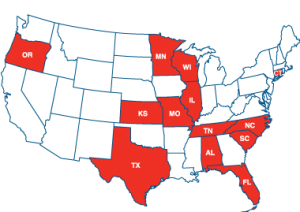Dry cleaning can be a dirty business.
 A staple of American corporate and family life for decades, dry cleaning poses environmental and health concerns due to the chemicals used in the dry cleaning process when not handled properly. Since the 1960’s, the majority of dry cleaners have utilized perchloroethylene, or perc, for their operations. Perc, which is also used to degrease metal machinery and in the manufacture of consumer products, is a known environmental and health hazard. While improved operational standards and modernized equipment have reduced impacts to soil and groundwater, there is still the risk of accidental spills, leaks, and contamination.
A staple of American corporate and family life for decades, dry cleaning poses environmental and health concerns due to the chemicals used in the dry cleaning process when not handled properly. Since the 1960’s, the majority of dry cleaners have utilized perchloroethylene, or perc, for their operations. Perc, which is also used to degrease metal machinery and in the manufacture of consumer products, is a known environmental and health hazard. While improved operational standards and modernized equipment have reduced impacts to soil and groundwater, there is still the risk of accidental spills, leaks, and contamination.
Human risks include non-cancerous effects such as kidney, liver, neurological, immune, and reproductive system damage, and risk increases proportionally to the amount and duration of exposure. High levels of brief perc exposure often produce symptoms such as dizziness, fatigue, headaches, confusion, nausea, and skin, lung, eye, and mucous membrane irritation, while long-term exposure can cause more serious problems. After laboratory testing of rats and mice as well as studies of dry cleaning industry workers, EPA has concluded that perc is a likely human carcinogen, and has included it as part of a category of carcinogenic volatile organic compounds (VOCs). It is important to note, however, that there has been no indication of increased cancer risk from simply wearing dry cleaned clothing.

Perc can enter the air, water, and ground during the cleaning, purification, and waste disposal phases of dry cleaning. Perc is released into the air through windows and vents, and, after a few weeks, breaks down into toxic and ozone-destroying chemicals. Perc that enters the ground through spills and leaks is highly toxic to plants, and, because perc does not bind well to soil, it travels very quickly into surface water, groundwater, and drinking water supplies. Even the smallest amount of perc can contaminate a large volume of water and be toxic to marine life, and EPA has set a limit on the amount of perc that is allowed to be in drinking water due to its toxicity. In addition to being detected in air, soil, and water, perc has also been found in food and breast milk. In fact, the dangers of perc are so plainly evident that, in 2007, the state of California passed legislation requiring the total phase-out of perc by 2023. In response to this legislation, the number of statewide traditional dry cleaners has dropped from 4,000 to less than 2,000 while the number of chemical-free dry cleaners, dubbed “wet cleaners,” has tripled.
Unfortunately, studies have indicated that 75% of operational dry cleaning establishments as well as countless former dry cleaning sites are contaminated. Costs to mitigate contaminated sites can reach hundreds of thousands of dollars or more, and many dry cleaners have simply been unable to afford the cost of cleanup. In an effort to assist dry cleaning business owners with these significant costs, 13 states have implemented programs to help with the cost of cleanup, and many more are considering such programs.
Established in 1998, the State Coalition for Remediation of Drycleaners (SCRD) is supported by the U.S. EPA Office of Superfund Remediation and Technology Innovation and is comprised of representatives of states with dry cleaner remediation programs in place. The funding programs are as follows:
- Alabama Drycleaning Environmental Response Trust Fund (DERTF)
- Connecticut Drycleaning Establishment Remediation Program
- Florida Drycleaning Solvent Cleanup Program
- Illinois Drycleaners Environmental Response Trust Fund
- Kansas Drycleaning Program
- Minnesota Pollution Control Agency Drycleaner Fund
- Missouri Drycleaner Environmental Response Trust (DERT) Fund
- North Carolina Dry-Cleaning Solvent Cleanup Act Program
- Oregon Dry Cleaner Program
- South Carolina Department of Health and Environmental Control: Drycleaning Restoration & Technical Assistance Section
- Tennessee Drycleaner Environmental Response Program
- Texas Dry Cleaning Remediation Program
- Wisconsin Department of Natural Resources Dry Cleaning Environmental Response Program
States without specific dry cleaner programs may participate in SCRD as “Represented States” if they have active remediation programs under other authorities. Currently, Alaska, California, Delaware, Maryland, New York, New Jersey, and Virginia are SCRD Represented States. In addition to these states, several others, including Massachusetts, are considering similar legislation. More information on these programs and resources can be found here.
With the increased burden of toxins on our environment, and with limited funding for remediation of dry cleaner sites, finding the most cost-effective and efficient means of mitigating site contamination is paramount. This includes second opinions, alternative mitigation techniques, and, in instances of pre-existing contamination, litigation. In the end, the most important factor is improving our health and the environment in which we live by reducing or eliminating toxic chemicals from the ground, water, and air. California may just have the right idea.
